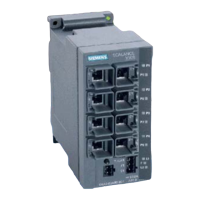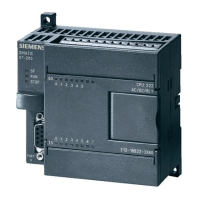Operating Your Text Display (TD) Device
5.5 Viewing the Screens and the Alarms
Text Display (TD) User Manual
System Manual, 08/2008, A5E00765548-03
115
Acknowledgement Required, Edits Allowed
In this combination of acknowledgement required and edits allowed, the TD device displays
the alarm, causes the entire alarm to flash (blink), and then waits until the operator
acknowledges the alarm and edits or accepts the values in the alarm. This type of alarm
requires that the operator edits or accepts the values displayed in the alarm. If the operator
aborts the edit by pressing the ESC key before editing all the values in the alarm, the alarm
flashes to indicate that edits are still required.
When the alarm is enabled in the S7-200 CPU, the TD device notes this and, if there is
space available on the display, reads the alarm from the CPU. The TD device then displays
the alarm and causes the entire alarm to flash to notify the operator that the alarm is present
and must be acknowledged.
Clearing an Alarm
● If an alarm required acknowledgement, the TD device will clear the alarm enable at the
same time that the Alarm Acknowledgement bit is set in the CPU.
● If an alarm contains editable variables, the TD device will clear the alarm enable bit when
all of the edits are completed and the last editable variable in the messages is written to
the CPU.
● The PLC program logic may clear the alarm enable bit at any time. This will remove the
alarm message from the TD display. An alarm message will not be removed from the
display if the user is editing a variable in the message or if the message has not yet been
acknowledged.
● If the message does not require acknowledgement and/or does not contain editable
variables, then the CPU program logic MUST clear the alarm enable bit.
Editing a Variable that is Embedded in an Alarm or a Screen
If you configured a screen or an alarm to include a variable, you can enter a new value for
the variable:
● Use ENTER to move the cursor to the variable. The TD device will write the updated
variable value to the CPU and set the edit notification bit for that variable when the
operator presses the ENTER key, completing the edit of the variable.
● Use the UP or DOWN arrows to change the value of the variable.
● Use the following buttons to move the cursor to different characters within the variable:
– TD 100C, TD 200C, and TD400C: LEFT and RIGHT arrows
– TD 200: SHIFT+UP arrow and SHIFT+DOWN arrow
● ESC reread
s the value of the variable from the S7-200 CPU and redisplays the value.
● ENTER writes the new value to the S7-200 CPU. (If the alarm contains other variables,
the cursor moves to the next variable.) The TD device will write the updated variable
value to the CPU and set the edit notification bit for that variable when the operator
presses the ENTER key, completing the edit of the variable.
If the variable was configured as a numeric string, the cursor skips over any non-numeric
characters in the message. See Chapter 4. After you have edited all of the variables in an
alarm, the TD device resets the alarm bit in the S7-200 CPU.

